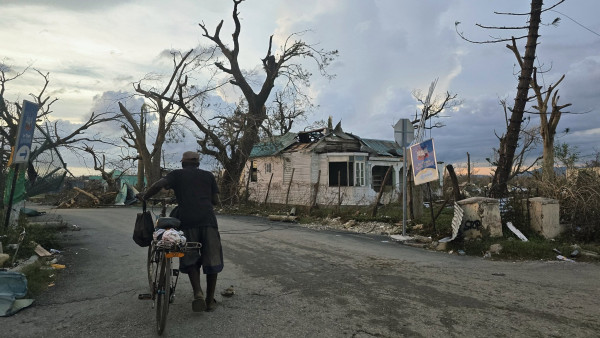I feel sad and angry at the same time. The sadness lingers, as the anger rises inside without warning. The heartbreak sits in my chest when I think about Jamaica, the land of my ancestors, being destroyed beyond recognition. It's now so different from my past pictures and memories - unrecognizable.
If you’ve found yourself feeling the same way and asking, “Why am I so emotional about this?”, know you are not alone.
We are sharing a collective community grief.
For many of us in the Jamaican diaspora (and across the Caribbean region), Hurricane Melissa is not just another storm on the news; it is deeply personal. This storm completely disrupted our sense of self and ways of being.
Even if we are not physically there, our hearts are connected to the land, to our families, to our history and our legacy. I have binge-watched videos of flooded homes, uprooted trees, washed-out roads and people thankful to be alive while standing among the debris of their belongings; and each time I felt the ache of helplessness knowing our people endured the devastation firsthand.
This is collective grief, a shared emotional response to loss and devastation that impacts a community we identify with.
Collective grief is a grief that transcends geography. It lives in our DNA where our bodies remember the hurt, pain and trauma, and our nervous system reacts in efforts to keep us safe. Our hearts hold the stories of generations that have survived hurricanes, displacement, enslavement and colonial legacies that made recovery harder than it should be.
All of this becomes activated in a shared collective grief.
And as with any grief, the process unfolds in stages, each one revealing something about our pain, our resilience, and our connection to home.
The 7 Stages of Grief in Collective Healing
1. Shock
The first stage of grief is shock. That moment of disbelief when reality has not yet registered. For many of us, watching Hurricane Melissa’s destruction brought a sense of numbness. It was too much to comprehend all at once. Shock is the body’s way of protecting us from the full force of emotional pain until we’re ready to face it.
2. Denial
Denial soon follows. It sounds like: “It can’t be that bad.” or “Maybe the videos are exaggerated.” It’s a natural psychological shield, a refusal to accept what feels unbearable. In this stage, we might scroll endlessly, hoping to see signs of normalcy, or avoid watching the news altogether. Denial offers temporary relief, but it can also delay the deeper emotions waiting beneath the surface.
{https://www.instagram.com/reel/DQzY5kIiaHV/?utm_source=ig_web_copy_link&igsh=NTc4MTIwNjQ2YQ==}
3. Anger
Then comes anger, and many of us (like me) have felt it deeply. Anger at the government’s slow response. Anger that we cannot connect with loved ones on the ground. Angry that our parish is not getting the attention and support. Anger at the injustice of climate change and how Caribbean nations continue to bear the brunt of global environmental harm. Anger at the world’s short attention span and how quickly the news cycle fades once the storm passes. But beneath that anger lies heartbreak. Because what we’re really mourning is the loss of safety, control, and connection.
Anger gives voice to the powerless parts of us. It reminds us that we care deeply, and that caring comes with pain.
4. Bargaining
Bargaining shows up as the “if only” moments:
“If only the infrastructure was stronger.”
“If only more people had been evacuated.”
“If only I could have sent help sooner.”
These thoughts reflect our mind’s attempt to make sense of loss and to restore some illusion of control. But sometimes there are no answers, only the invitation to hold space for what feels unresolved.
5. Depression
As reality sets in, so does the heaviness of grief.
You may notice yourself withdrawing, feeling emotionally drained, or carrying a quiet sadness throughout the day. This stage can look like emotional and/or physical exhaustion, irritability, or disinterest in things that usually bring joy. And while these feelings can be overwhelming, they are not a sign of weakness. They are the body’s way of slowing down to process the depth of what has been lost, both personally and collectively.
If you notice yourself sinking into prolonged sadness or hopelessness, please seek support from a registered mental health professional, our team at Natacha Pennycooke Psychotherapy can support you through this time. You do not have to carry the weight alone.
6. Acceptance and Hope
Acceptance does not mean we are “over it.” And neither does it mean complacency. It means we are learning to live with what has happened while beginning to reclaim our sense of agency.
Hope emerges as we reconnect with others, with community, with the belief that healing is possible. It’s found in the people organizing fundraisers, sending care packages, sharing prayers, and holding space for one another online and in-person.
Acceptance is the quiet realization that even amid destruction, there can still be life, purpose, and renewal in our resilience.
7. Processing the Grief
The final stage is processing the grief, where we give ourselves permission to grieve fully and in our own way.
For some, it’s through prayer and storytelling. For others, through music, art, or gathering in community. Grieving collectively helps transform sorrow into solidarity, and pain into purpose.
Processing means acknowledging that grief is not linear, it comes in waves, and each wave carries both hurt and healing.
As we begin to process our grief, many of us are also navigating a unique layer of mourning: Diaspora grief, the grief that comes with the distance of being physically away from our homeland. The kind that stretches across oceans, time zones, and memories of home.
Diaspora grief is also complex. We feel the pain of distance while managing the guilt of privilege. We go about our daily lives, while scrolling through images of destruction back home, wondering, “What can I even do from here?”
That dissonance, the gap between being safe where you are and knowing others are not, is exhausting. It can leave you feeling emotionally split, restless, and powerless.
This is the emotional cost of belonging to two places at once.
{https://www.instagram.com/p/DRLD5tXDjYd/?hl=en}
What do we do with all of this?
We start by acknowledging what’s here: the anger, sadness, heartbreak, guilt, and the love that fuels it all. We name it. We breathe through it. While we remind ourselves that feeling deeply is a sign of connection, not weakness.
Here are a few ways to begin processing what you’re feeling:
1. Pause and breathe. Allow yourself to slow down, even for five minutes. The nervous system needs gentle reminders of safety.
2. Name your emotion. “I feel angry.” “I feel helpless.” “I feel heartbroken.” Naming helps regulate.
3. Connect with community. Join a healing circle, call friends, family and like-minded people, sit in prayer. Sharing positive spaces lessens isolation.
4. Give what you can. Financially, emotionally, spiritually, or volunteering your time helps to transform helplessness into empowerment.
5. Hold compassion for yourself. You do not have to be okay right now. Healing takes time, and your emotions are valid.
Remember this:
Grief is love with nowhere to go. Your heartbreak is evidence of your connection to home, your people, and your roots. And while the storm may have passed, the emotional waves are still finding their way to shore.
Let’s hold space for that together.
If you are experiencing difficult emotions around grief, loss, sadness or other life transitions, our team of registered mental health professionals can help you heal the hurt, pain and trauma to find peace and joy again.

 By
By 





